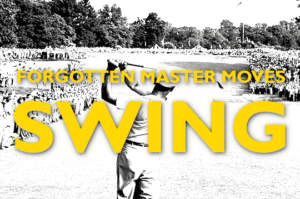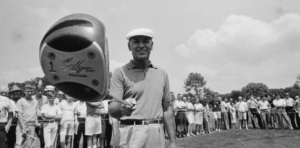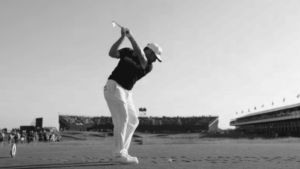
A Transition Free Golf Swing – Is this Possible?
The transition part of the golf swing can be tough to master. It happens incredibly quickly (even quicker for those performing it), and many swing instructions want you to focus on an intense transition move before continuing the swing. So, does a transition free golf swing exist?
To answer the question directly: No, you need a transition. However, it can be simplified to the point where, after intentionally training driving parts, you never have to consciously think about it.
The key lies in the swing style you’re aiming for. By understanding how to utilize the swing arc in the old school / FMM way, you remove the need for a dramatic transition move. This approach emphasizes smoothness and flow throughout the swing, rather than forcing an intense, separate transition. Over time, the swing becomes more natural, and the transition feels like a seamless part of the entire motion.
For reader context: this article is a part of the FMM Swing Page (my system for teaching the great’s core movements). I recommend that you start here instead.
The Club Shallowing Transition Move – Lack of Width Bandaid
Let’s go to the roots of the issure. You need to get shallow into the golf ball to perform nice striking. If you are e.g. 10 degrees in attack angle you will destroy your ability to perform long nice shots (since the spin rate will go through the roof). That’s the issue here. The needed shallowness.
Most golfers tend to have a relatively tight backswing arc and lack a clear, defined power input into their swing (you can read more about that here). This combination often leads to a short downswing arc, which results in the “steep striking dilemma.” In this scenario, it’s difficult to strike the ball properly unless a shallowing move is introduced.
Is there anything wrong with a shallowing move? The short answer is: it depends. In theory, it’s fine. But in practical execution, it’s a different story. It’s incredibly difficult to perform, especially from a mental perspective. You would likely need tens of thousands of repetitions before this move even begins to manifest in your muscle memory. And it won’t manifest unless your power system—your swing mechanics and how you generate speed—aligns with it.
Standard Non Transition Free Golf Swing Moves
The key issue here is that you start with a tight backswing, lacking width. This leaves you in need of a solution to achieve the desired shallowness in the downswing.
The most common instruction for this is to use the forearms to shallow the club, often by feeling like the club falls behind you. Alternatively, some golfers employ a technique similar to Sergio Garcia’s “chain pull” move. Both of these methods are potent because they allow your hands and clubhead to approach the ground effectively. The challenge, however, is that these moves often result in an opening of the clubface. This presents a tough situation: you need to consistently strike the ball with a reduced swing arc, which is a significant challenge. No wonder that Mr Garcia is considered a generational talent. In my opinion, it’s actually easier to perform the opposite of a clubface opening, although this feels very counterintuitive. But it works when you understand how the forces at play (which are invisible to the eye) actually work in your favor.
Another way to approach the shallowing issue is by using an intentional trail arm extension during the downswing, while still maintaining lag. This is a more mechanical thought process and requires a great deal of mental focus and muscle control. Separating the triceps in this transition area can be challenging, but it’s an effective technique taught in many MORAD protocols. Despite the difficulty in thinking about this movement, it holds high technical validity and is a solid strategy for improving your swing.
Sounds pretty demanding to do?
Super Transition Move = A Baseball Swing Component
The “super transition move” is a powerful shallowing technique used in the modern, baseball-inspired golf swing. This model utilizes a distinct power creation structure that differs greatly from what most amateur golfers do subconsciously.
The essence of the super transition move is about delaying the “strike” until it’s generated through the sling you’ve created in the transition. Essentially, instead of the strike happening directly, it occurs because of the stored power created by this sling-like motion.
Technically, you start by getting into a solid backswing position that aligns with the swing system. Then, your body outraces your arms, which stores the sling power. The transition move itself is responsible for more than 50% of the success in this type of golf swing.
It’s a specialized swing style that’s incredibly potent, but it demands a lot from the golfer in terms of timing, coordination, and physicality. If you’ve played baseball, the advantage is significant, as the similar mechanics in both sports help with the transition and the ability to store and release power. However, even for skilled players, mastering this style can be a challenge, but the potential for power and control is immense once it clicks.
“Transition Free Golf” Solutions
I agree that transition moves can be challenging to implement into your swing style, especially when you’re trying to find a way to create shallowness without complicating things too much. The three solutions you mentioned offer practical ways to achieve this while staying true to a more effortless style of golf:
- Wider Backswing Position: While this can certainly help with shallowness, it does introduce tension, which can be counterproductive for an effortless feel. It works for some, but I agree it’s not always ideal.
- Downswing Arc Creating Width: Using the downswing arc to create width with the clubhead is a more fluid approach. The idea of using the club itself to feel the width rather than forcing a movement with the arms makes it a more natural, integrated motion.
- Impact Zone and Club Angle: Inducing shallowness by aiming the club more upwards through the impact zone is a fantastic strategy that feels much more intuitive and doesn’t require as much mechanical thought. Read about it here.
If you grind what you read above into your system you are actually moving into the realm of what the old greats did. It opens up for much higher hands if wanted (for free power) and generally steep body positions which will help you to move naturally in the follow through. Nicklaus, Watson, Miller, Weiskop or why not more modern Daly, Bubba Watson etc springs to mind. It’s basically a transition free golf swing.
It took me eight years of studies and experimentation to figure out the delicate connections and interdependencies of what I write above. And another two regarding how to teach it.
Please click here to go back to the The FMM Swing Page.
More FMM Swing Articles

The Golf Swing Timing – Allowing Natural Forces To Shine?
When you’ve played your best golf, it probably felt like nothing. Your golf swing timing was so on point that you could simply play the game without overthinking. You’ve likely hit 5–10 shots in…

The Golf Swing Plane and Circle: Natural or Manipulated?
The golf swing is a bit strange in that some of the observed behavior just happens, while other aspects are enforced or acted upon. You have the observed golf swing plane and the circle…

Swing Intentions – The Missing Piece for Great Golf?
Ever thought that what professionals (or the awesome players at your club) are doing isn’t quite the same as what you’re doing? Ever wondered if you can accurately draw conclusions about someone’s swing by…
Some General Swing Tech Posts (with Videos)

Flat Golf Clubs = Magic Cheat Code for Power & Accuracy?
Flat Golf Clubs = Magic Cheat Code for Power & Accuracy? I play 4-degree flat golf clubs despite being 5’11” (181 cm) with normal arm length. Why? Because the old-school golf swing relies on…

Complete Club Connection – Golf Swing Harmony
Complete Club Connection – A Harmonic Feel A great benefit of using the swing arc like the old greats did is achieving complete club connection in your golf swing motion. You’ve probably heard advice…

Abstract Golf Beats Mechanics – Feel Over Technique
Abstract Golf – What the H*ck do I Mean? Being too mechanical and overly internalized makes both the game and performance suffer. Most importantly, it takes you out of the moment and makes you…
Golf Development Consulting
I offer some services for you that are into golf technique and want some assistance.

Show Stopper Analysis – Golf Development Consulting
The Show Stopper Analysis is for you that simply don’t know what’s going wrong. I don’t charge anything for this and perform my analysis round once a week. The Deep Analysis / Jungle Guiding is for…

Deep Analysis / Jungle Guiding – Golf Development Consulting
The Deep Analysis / Jungle Guiding is about dealing with information overload. One of the biggest problems with doing it yourself and “not going as deep as you need to” is that you start taking someone…
General Article Collection Pages

DIY Swing Change – Advice on How to Successfully Change
Do It Yourself, DIY Swing Change, is what has driven me the last decade in my golf swing development. The absolute enjoyment of figuring out a swing change myself. To all of you out…

The FMM Swing – Reviving Old-School Secrets for Modern Golf
The FMM Swing system is the result of my mission to understand the inner workings of the old-school greats—and to adapt them to modern golf. I spent eight years figuring it out and two…

Golf’s Best Systems – Much Needed Golf Technique Context
I categorize golf motion styles into systems for the sake of clarity and understanding. No golfer fits perfectly into a single system, but without a structured framework, you’re essentially shooting in the dark. These…
Old School General Articles

Ben Hogan Swing Rebuild – The Breakthrough That Changed Golf Forever
Nothing in golf quite compares to Hogan’s dominance in the 1940s and 1950s. The Ben Hogan swing rebuild, which he eventually shared through Five Lessons and other insights, shook the golf world—but without the…

The Death of the Swinging Motion – A Resurrection Possible?
If you’ve read my golf’s greatest swingers article you see that I highlight changes to the golf swinging motion happening roughly between 1970-1990s. You could basically call this the death of the swinging motion….

Old School Swinging Elements on Tour – A Modern Case Study
Modern top tier golfers definitely display old school swinging elements of the old greats. These swing styles are making their way back to the leaderboards today. How to spot Old School Swinging Elements? Once…